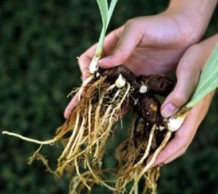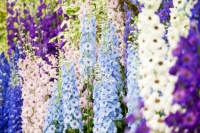![]() Prices in Canadian Dollars.
Prices in Canadian Dollars.![]() Prefer to call and speak to a floral agent? 1-877-277-4787
Prefer to call and speak to a floral agent? 1-877-277-4787
Perennial Garden Plants
Perennial Garden Plants
A perennial plant (often referred to as simply a perennial) is a plant that lives for more than two years. The term is often commonly used to differentiate a particular plant from shorter lived Annuals or Biennials. Perennial plants can be short-lived (only a few years) or they can be long-lived, as are some woody plants like trees which can live for over 4,000 years. They can vary in height from only a few inches to over 300 feet tall.
Perennials, especially smaller flowering plants will bloom over the spring and summer and then die back every autumn and winter, returning in the following spring from their roots rather than seeding themselves as an annual plant does. These are known as herbaceous perennials. However, depending on the rigors of the local climate, a plant that is a perennial in its native habitat, or in a milder garden, may be treated as an annual and planted out every year, from seed, from cuttings or from root divisions.
In warmer and more favorable climate zones perennials grow continuously. In climates zones with distinct seasons, their growth is limited to the warmer seasons (Spring, Summer, Early Fall). For example, in temperate regions a perennial plant may grow and bloom during the warm part of the year, with the foliage dying back in the late fall or winter. These plants are deciduous perennials whose regrowth is from existing stem tissue. In some species, perennials retain their foliage all year round; these are evergreen perennials.
Gardening with Perennials
 Perennials from a gardeners point of view can be the foundation of your garden due to their incredible staying power, with each month during the growing season bringing new blooms, and each year seeing continued growth. Generally the first year you plant perennials, the flowers may be sparse, the plants small, with the space in between seeming huge. But be patient and don’t panic! By the second year, you’ll see more flowers and better growth. But generally by the third season – step back – your plants may look like someones been slipping them steroids. So the key is to carefully select perennials based on their requirements for light, soil , and moisture, and pay close attention to their predicted eventual spread and height.
Perennials from a gardeners point of view can be the foundation of your garden due to their incredible staying power, with each month during the growing season bringing new blooms, and each year seeing continued growth. Generally the first year you plant perennials, the flowers may be sparse, the plants small, with the space in between seeming huge. But be patient and don’t panic! By the second year, you’ll see more flowers and better growth. But generally by the third season – step back – your plants may look like someones been slipping them steroids. So the key is to carefully select perennials based on their requirements for light, soil , and moisture, and pay close attention to their predicted eventual spread and height.
Here are some things to look for when selecting perennials:
- Longevity (90 percent alive and thriving five years after planting)
- Resistance to disease and insects, so you don’t have spray them continuously
- Don’t need to be divided more often than every four or five years
- Tolerance of a wide range of growing conditions
- Cold hardy – no winter protection needed. Be sure to check your Zone Map
- Tolerance of summer heat (depending of course on your summer climate)
- Long blooming period, or foliage that’s attractive all season
- Won’t take over your garden. Pay close attention to this one as some perennials will spread with time like wildfire and go from being a great garden addition to being a real problem in later years.
- Don’t require staking.
Selecting Perennials
Your selection of specific perennials will depend greatly on the Climate Zone you live in. So the first step is to check our Climate Zone Map so you know what range you fall into. Once you have done that here are a few other considerations that may or may pertain to your specific planting area
Winter survival of plants is affected by many factors in addition to low winter temperature “zones”:
- Freeze-Thaw Cycles during the winter often cause more damage than consistent cold temperatures.
- Snow Cover provides an insulating effect for plants, at times lack of snow cover may result in damage.
- In late winter Sun Scald can crack the bark of many roses.
- Many plants can be damaged by a Late Spring Frost, especially plants that tend to put out buds early in the spring. Late frosts will rarely cause a hardy rose to die — it mostly affects the early bud growth.
- Frost in low-lying areas can delay the onset of growth in the spring: for example, the nursery in spring is typically 2-4 C colder than the fields 50 meters away.
- Road Salt and pollutants can have a major effect on winter survival in some species.
Now here are just a few more questions to answer before you purchase and plant your first perennial flower.
- What kind of soil do I have? Wet versus Well Drained
- How tall do I want my flowers to be? Best to decide before planting.
- How much area do I have to plant? This will determine spread and number of plants you need to purchase and will save you from making multiple trips or having too many plants.
- What colors should I select? Flowers of red, pink, blue, and purple are “cool” colors and will soften a garden, where as range and yellow are “hot” colors and will brighten a garden.
Another important factor has more to do with the gardener, than the actual plants themselves. Before making your final selection ask yourself, “How much time do I have on an ongoing basis to maintain my garden?” If the time that you can spare to maintain a garden is limited, don’t select plants that need special attention. Avoid plants such as dahlias that must be lifted in fall and stored over winter… not unless you willing to think of them like annuals. Or irises that require regular division to look their best.
The answers to the above questions will dictate the perennials that are best suited for your garden and will help you select plants when you visit your garden center.
Planting Perennials
Generally most perennials are best planted in the spring as the earlier perennials are planted the more developed the root system will be when the plant enters the winter. Plantings running into the fall can sometimes result in frost heaving and loss of the plant. Perennials should be planted at the same depth they were grown in the container, as planting too high will result in plants drying out and planting too low allows crown rots. Perennials purchased as bedding plants should be watered before planting
Maintaining and Caring for Perennials
Here are some very general guidelines for maintaining perennials, for more detailed information on a particular plant there are many books or internet resources available.
- Prune off any dead tops in late winter or early spring.
- Remove dead flowers regularly to encourage repeat blooming.
- Water during drought if possible; early morning watering avoids losing much to evaporation during the heat of the day.
- Clip back scruffy-looking plants to promote fresh, attractive growth. Late spring and early summer perennials often could use a good serious clip after blooming.
- Control any pests and diseases as soon as noticed, to avoid spreading the problem to other plants.
- Stake tall plants like Peonies and Delphiniums before they reach 2 feet tall, this will help avoid wind damage later.
- Divide perennials when the center of the plant begins to die out with age.
Dividing Perennials
 The task of “dividing” is a typically required one in most perennial gardens and is an important part of maintaining healthy plants and a beautiful (not overcrowded) garden. There are no firm rules as to when to divide perennials, in fact if you were to ask a dozen gardeners from different regions this question you would be unlikely to get the same answer twice. Some perennials may need division every 3-5 years, some 8-10 years and some you can simply leave on their own. Generally spring is the best time to undertake this task, however some of the “fleshy rooted” perennials such as poppy, peony, and iris are best divided in the late summer to very early fall. While many perennials such as hostas and daylilies are easy to divide, those with taproots are more difficult, such as monkshood (Aconitum), baby’s breath (Gypsophila) and butterfly weed (Asclepias tuberosa).
The task of “dividing” is a typically required one in most perennial gardens and is an important part of maintaining healthy plants and a beautiful (not overcrowded) garden. There are no firm rules as to when to divide perennials, in fact if you were to ask a dozen gardeners from different regions this question you would be unlikely to get the same answer twice. Some perennials may need division every 3-5 years, some 8-10 years and some you can simply leave on their own. Generally spring is the best time to undertake this task, however some of the “fleshy rooted” perennials such as poppy, peony, and iris are best divided in the late summer to very early fall. While many perennials such as hostas and daylilies are easy to divide, those with taproots are more difficult, such as monkshood (Aconitum), baby’s breath (Gypsophila) and butterfly weed (Asclepias tuberosa).
How will you know if a perennial needs to be divided? Watch for the signs…..
- Flowering is reduced with the flowers getting smaller as the clump become congested.
- Growth in the center of the plant dies out leaving a hole with all the growth around the edges, think of this as the “doughnut effect”.
- Plant loses vigor.
- Plant starts to flop or open up needing staking.
- Plant has simply outgrown its bounds.
Although dividing may sound complicated it is actually quite simple. Don’t worry about being too hard on a plant that’s made itself comfortably at home in your garden. As long as each division has several good roots and some healthy foliage, the plant should take well to division. Here are the steps to follow:
- If the soil is hard around the plant soak it down a couple of days before you plan to divide it. The soil should be soft so that it is easy to dig, but not so wet that it is muddy and sticks to your garden tools.
- Dig around the plant and and gently lift the entire clump out of the ground.
- Cut the clump (using a garden spade or sharp knife) into pieces up so that each clump is the size of a quart or gallon sized perennial. Place the clump on a tarp as this will make clean up easier.
- Discard the old, dead center and trim off any long or damaged roots.
- The divisions should be kept moist and shaded while you prepare the new planting site. If planting back into the old location be sure to add some compost and work the soil well.
- Once planted ensure that the you water the divisions well to prevent drying out



